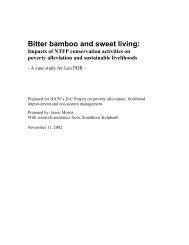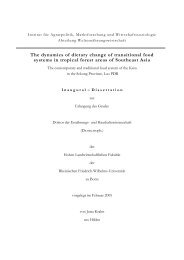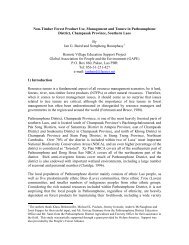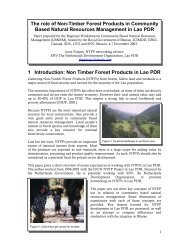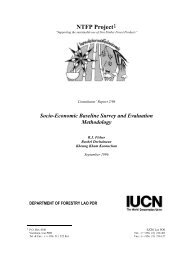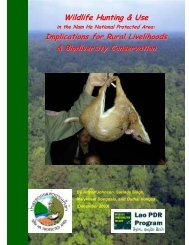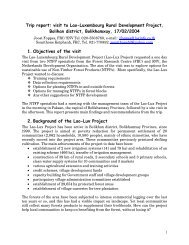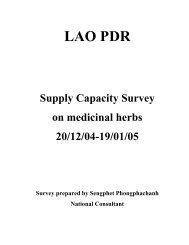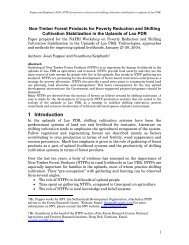Create successful ePaper yourself
Turn your PDF publications into a flip-book with our unique Google optimized e-Paper software.
4.2 Household interviews<br />
4.2.1 The role of NTFP’s in the family ec<strong>on</strong>omy<br />
The third method we used to assess the importance of NTFP’s was a short questi<strong>on</strong>naire<br />
survey, focusing <strong>on</strong> the family ec<strong>on</strong>omy, interviewing 100 families in 5 villages. NTFP’s are<br />
the most important source of cash income (40%) over all villages (see table 5). They are<br />
especially important for those villages that live <strong>on</strong> the edge of the forest, i.e. Ban Kh<strong>on</strong> Ken<br />
(73%), Ban Ka-Oy (60%) and Ban Sopphene (68%). In Ban <strong>Nakai</strong> Neua and Thalang, many<br />
families have off-farm income sources such as salaries or income from trading.<br />
These data differ from those of the group ranking exercises described in paragraph 4. We<br />
tend to think that the family based interviews are more reliable than the group discussi<strong>on</strong>s. It<br />
could be that group meetings are dominated by village leaders who are often wealthier and<br />
have a larger family size, hence tend to collect more NTFP’s and buy less rice than the<br />
average family. It is likely that selling of livestock is c<strong>on</strong>sidered shameful and not readily<br />
admitted to in group discussi<strong>on</strong>s, hence underestimated. The truth is probably somewhere in<br />
the middle. At any rate NTFP’s are without doubt the most important source of income over<br />
all families.<br />
More than half of the cash income was spent <strong>on</strong> buying rice in 1996. In Ban Ka-Oy and Ban<br />
Sop Phene, families needed to buy much more rice than could be bought from their cited cash<br />
income. It seems likely that rice shortages did already occur in many families in 1996.<br />
Table 5: Average family budgets, 5 villages, <strong>Nakai</strong> plateau, 1996.<br />
Village 9eo;o7v[7q; Kh<strong>on</strong>ken Kaoy <strong>Nakai</strong> Sopphene Thalang AVERAGE %<br />
Total No Families 9eo;o7v[7q; 35 25 57 40 41<br />
NTFP's 1996 7 x f !__* 116,457 141,627 84,407 35,495 62,722 82,926 41%<br />
Livestock laf]Ph' 42,583 95,079 130,449 16,750 21,463 64,914 32%<br />
Off-farm ovd9kdg7njv'd}d 0 0 110,246 0 118,130 56,199 28%<br />
GROSSVALUE ]kpIa[ma's,qf 159,040 236,706 325,102 52,245 202,315 204,038 100%<br />
Rice*** g0Qk -48,060 -397,786 -33,025 -172,215 -147,293 -133,519 -65%<br />
NET VALUE ]kpIa[ 110,980 -161,080 292,076 -119,970 55,023 70,519 35%<br />
*) Amount of m<strong>on</strong>ey needed to buy rice (negative values) or surplus rice sold (positive values), based <strong>on</strong> a<br />
calculati<strong>on</strong> of surpluses after family c<strong>on</strong>sumpti<strong>on</strong>, calculated as 300 kg/head/year.<br />
Because of the excepti<strong>on</strong>al floods of 1996, the amount of rice produced for 1997 will be<br />
extremely low and families have to spend more m<strong>on</strong>ey <strong>on</strong> buying rice. They increased their<br />
income from NTFP’s and sold more cattle (see table 6). It should be noted that these data<br />
were collected in March 1997, which means another 6-7 m<strong>on</strong>ths will pass before the next rice<br />
harvest will happen. Most likely villagers will try to sell more livestock and collect more<br />
forest products to buy rice in the mean time. Many families will face serious rice shortages<br />
this year.



